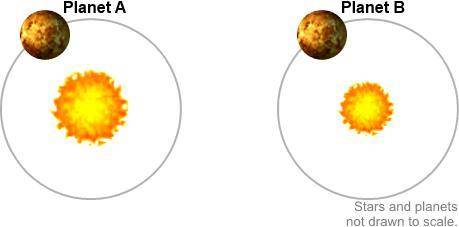
Physics, 01.03.2021 09:40 ayeletstrauss
According to the law of universal gravitation, any two objects are attracted to each other. The strength of the gravitational force depends on the masses of the objects and their distance from each other.
Many stars have planets around them. If there were no gravity attracting a planet to its star, the planet's motion would carry it away from the star. However, when this motion is balanced by the gravitational attraction to the star, the planet orbits the star.
Two solar systems each have a planet the same distance from the star. The planets have the same mass, but Planet A orbits a more massive star than Planet B.
Which of the following statements is true about the planets?
A.
Planet B is more attracted to its star than Planet A.
B.
Planet B will keep orbiting its star longer than Planet A.
C.
Planet A orbits its star faster than Planet B.
D.
Planet A has a longer year than Planet B.


Answers: 3
Another question on Physics

Physics, 22.06.2019 02:30
Awave travels at a speed of 5.2 m/s. if the distance between crests is 0.40 m, what is the frequency of the wave? use f=v/wavelength a. 13 hz b. 2.1 hz c. 0.077 hz d. 5.6 hz
Answers: 1

Physics, 22.06.2019 02:30
Which type of bond is found between the atoms of a molecule? a. metallic b. delocalized electron c. covalent d. ionic
Answers: 1

Physics, 22.06.2019 08:00
While studying chemical reactions and conservation of matter, sarah's class conducted a variety of experiments. sarah and her lab partner found the mass of a wax candle and placed the candle in a flask. the students lit the candle and let it burn to completion. all that was left was wax and charred candle wick. per their teacher's instructions, the students found the mass of the products. their data can be seen in the data table. formulate a hypothesis the students could test to explain why the experiment did not support the law of conservation of matter. a) the students could repeat the experiment using different candles; there might have been a flaw in the candle. b) the experiment should be repeatable. the students should run several trials and then take an average of the after mass in each trial. c) the students should have someone in the class check their measurement skills as they repeat the experiment. they may have made an error using the balance. d) the students should burn the candle in a container that has some type of lid so that any gas that is a product of the reaction can be contained and massed. submit
Answers: 2

Physics, 22.06.2019 11:30
(2) (a) you have a simple circuit that consists of only a battery (δvbat=1.5v) and two resistors with resistance r1=10ω and r2=5ω, connected in series with each other. what is the current running through the battery? (b) you re-arrange your circuit so now r2 is attached in parallel to r1 rather than in series. what is the current running through the battery? (c) you add an additional resistor r3=7ω on the same branch as r2. what is the current running through the battery? (d) what is the power dissipated in r3?
Answers: 3
You know the right answer?
According to the law of universal gravitation, any two objects are attracted to each other. The stre...
Questions


Computers and Technology, 25.02.2020 00:51












Mathematics, 25.02.2020 00:51



Mathematics, 25.02.2020 00:51


Mathematics, 25.02.2020 00:51

English, 25.02.2020 00:51



